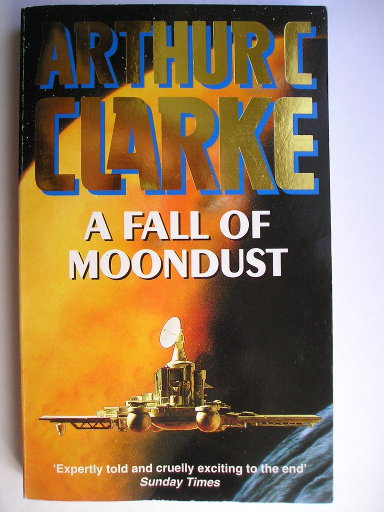
The novel “A Fall of Moondust” by Arthur C. Clarke was published for the first time in 1961.
The Selene is a boat very different from those that travel to Earth. It sails on the layer of dust covering one of the seas on the Moon. For this reason, it’s more like a spacecraft than a boat of the Earth’s seas but it’s not equipped with engines for space travel.
During a cruise, an moonquake causes the collapse of an underground cave upsetting the balance of the layer of dust on it. When the Selene passes in that area, sinks and ends about 15 meters below the dust surface. The signal transmitted by boat’s beacon is no longer received and that warns the authorities but as how can they find the Selene and rescue its crew and passengers before they run out of oxygen?
“A Fall of Moondust” was written in 1960, when our knowledge about the Moon came only from observations with telescopes. Many areas of its surface seemed very smooth so scientists theorized that the local rocks were pulverized over time because of the dramatic change in temperature between day and night to form a sort of sea.
Arthur C. Clarke wasn’t the first to use that idea in a science fiction story but in “A Fall of Moondust” it becomes central. According to the author, the layer of dust many meters thick accumulated in time behaves like a fluid enabling a boat to sail above it. However, when a moonquake upsets the balance of this kind of sea, the boat Selene sinks beneath its surface.
The adventure that follows the incident forms a catastrophic thriller being the story of the efforts of the Selene’s crew and passengers to survive and the attempts to rescue them from the outside. It’s a novel in Arthur C. Clarke’s style, so it’s hard science fiction in which the technical and scientific component is crucial.
In catastrophic stories, often the threats to the the protagonists’ lives follow one another without a real logic, just to keep the tension high. On the contrary, in “A Fall of Moondust” Arthur C. Clarke is very careful in building the basis of the novel so that any danger is the effect of a cause very precise and absolutely plausible in terms of technology and science.
The author manages to find a good balance between the need for a story of this kind to keep the tension high and the explanations of the causes of the dangers and of the problems encountered by the rescuers. Even in the efforts of the crew to keep up the passengers morale you can see the Arthur C. Clarke rationality.
Character development was considered a weak point of the author, in “A Fall of Moondust” at least some of them are fairly developed. He uses some cliches but in this novel there are many characters so it was inevitable that Arthur C. Clarke focused on the protagonists. I think the result is more than acceptable, also because the protagonists are not supermen but people who also show limits and flaws.
Inevitably, all the technical and scientific part of “A Fall of Moondust” is developed according to the knowledge of 1960. The space probes sent to the Moon in the following years allowed to establish that the seas of dust didn’t exist. Arthur C. Clarke admitted without problems that the story was no longer plausible and perhaps could be moved to Mars. Today there are doubts about the red planet as well as a setting but this happens because of the advancement of our knowledge.
Today “A Fall of Moondust” is in some ways dated but the story is still solid and interesting maintaining its tension. Due to its characteristics, especially fans of catastrophic stories and hard science fiction can like it.


Permalink